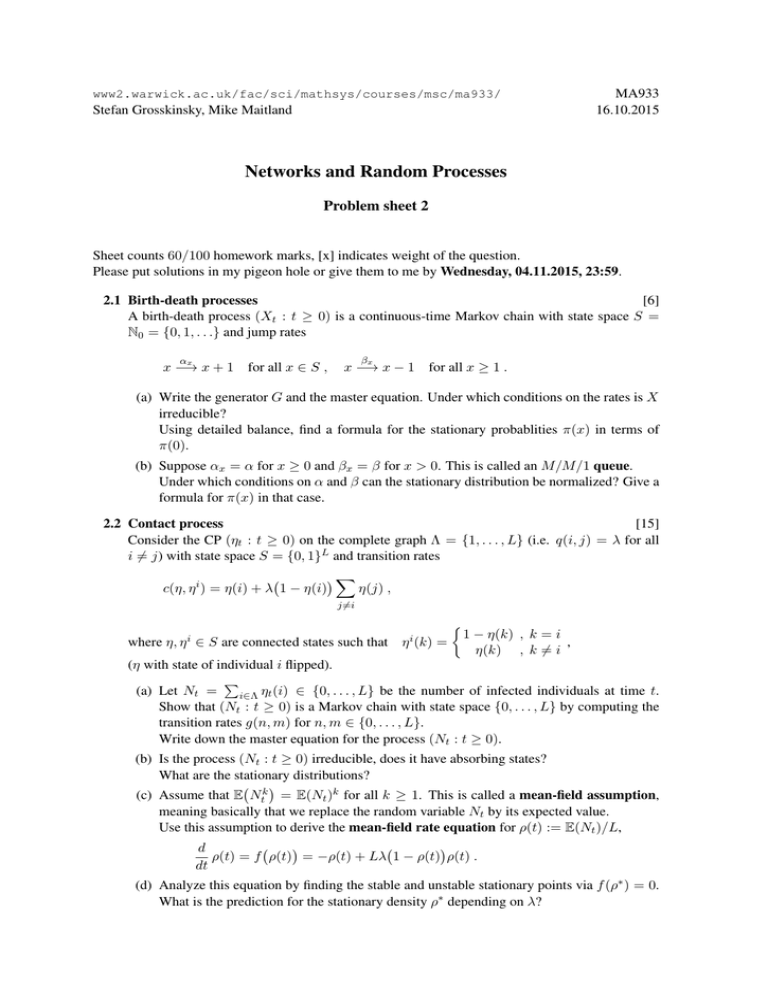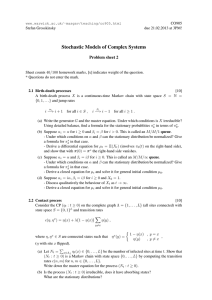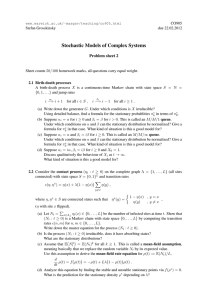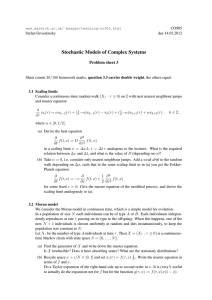Networks and Random Processes Problem sheet 2
advertisement

www2.warwick.ac.uk/fac/sci/mathsys/courses/msc/ma933/
Stefan Grosskinsky, Mike Maitland
MA933
16.10.2015
Networks and Random Processes
Problem sheet 2
Sheet counts 60/100 homework marks, [x] indicates weight of the question.
Please put solutions in my pigeon hole or give them to me by Wednesday, 04.11.2015, 23:59.
2.1 Birth-death processes
[6]
A birth-death process (Xt : t ≥ 0) is a continuous-time Markov chain with state space S =
N0 = {0, 1, . . .} and jump rates
α
x
x −→
x+1
for all x ∈ S ,
βx
x −→ x − 1
for all x ≥ 1 .
(a) Write the generator G and the master equation. Under which conditions on the rates is X
irreducible?
Using detailed balance, find a formula for the stationary probablities π(x) in terms of
π(0).
(b) Suppose αx = α for x ≥ 0 and βx = β for x > 0. This is called an M/M/1 queue.
Under which conditions on α and β can the stationary distribution be normalized? Give a
formula for π(x) in that case.
2.2 Contact process
[15]
Consider the CP (ηt : t ≥ 0) on the complete graph Λ = {1, . . . , L} (i.e. q(i, j) = λ for all
i 6= j) with state space S = {0, 1}L and transition rates
X
c(η, η i ) = η(i) + λ 1 − η(i)
η(j) ,
j6=i
where
η, η i
∈ S are connected states such that
η i (k)
=
1 − η(k) , k = i
,
η(k) , k 6= i
(η with state of individual i flipped).
P
(a) Let Nt =
i∈Λ ηt (i) ∈ {0, . . . , L} be the number of infected individuals at time t.
Show that (Nt : t ≥ 0) is a Markov chain with state space {0, . . . , L} by computing the
transition rates g(n, m) for n, m ∈ {0, . . . , L}.
Write down the master equation for the process (Nt : t ≥ 0).
(b) Is the process (Nt : t ≥ 0) irreducible, does it have absorbing states?
What are the stationary distributions?
(c) Assume that E Ntk = E(Nt )k for all k ≥ 1. This is called a mean-field assumption,
meaning basically that we replace the random variable Nt by its expected value.
Use this assumption to derive the mean-field rate equation for ρ(t) := E(Nt )/L,
d
ρ(t) = f ρ(t) = −ρ(t) + Lλ 1 − ρ(t) ρ(t) .
dt
(d) Analyze this equation by finding the stable and unstable stationary points via f (ρ∗ ) = 0.
What is the prediction for the stationary density ρ∗ depending on λ?
2.3 Simulation of CP
(Sample code on the course webpage)
[15]
Consider the contact process (ηt : t ≥ 0) as defined in Q2.2, but now on the one-dimensional
lattice ΛL = {1, . . . , L} with connections only between nearest neighbours, i.e. q(i, j) =
q(j, i) = λδj,i+1 , and periodic boundary conditions.
The critical infection rate λc can be defined such that the infection on the infinite lattice Λ = Z
started from the fully infected lattice dies out for λ < λc , and survives for λ > λc . It is known
numerically up to several digits, depends on the dimension, and lies in [1, 2] in our case.
All simulations of the process should be done with initial condition η0 (i) = 1 for all i ∈ Λ.
(a) To get a general idea, simulate the process for e.g. LP= 256 for several values of λ ∈
[1, 2]. Plot the number of infected individuals Nt = x∈ΛL ηt (x) as a function of time
up to time 10 × L, averaging over 100 realizations in a double-logarithmic plot to find the
window of interest for the parameter λ, choosing e.g. λ = 1, 1.2, . . . , 1.8, 2.
What is the expected behaviour of Nt depending on λ?
(b) Then use fine increments of 0.01 for λ and averages of at least 500 realizations to find an
estimate of the critical value λc (L) ∈ [1, 2].
Repeat this for different lattice sizes, e.g. L = 128, 256, 512, 1024, and plot your estimates of λc (L) against 1/L. Extrapolate to 1/L → 0 to get an estimate of λc = λc (∞).
This approach is called finite size scaling, in order to correct for systematic finite size
effects which influence the critical value.
(c) Explain how to set up an update loop that can be used to simulate the contact process on
a general connected, undirected graph.
2.4 Dorogovtsev-Mendes-Samukhin model
[12]
Consider the following generalization of the Barabási-Albert model. Starting with m0 = 5
connected nodes, in each timestep a node j is added and linked to m = 5 existing distinct
nodes according to the probability (to be adapted to avoid double edges)
k0 + ki
,
i∈V (t) (ki + k0 )
πj↔i = P
k0 ∈ N0 .
Simulate the model for three different values of k0 = 0, 2, 4 to generate graphs of size N =
|V | = 1000, with 20 independent realizations in each case.
(a) Plot the tail of the degree distribution in a double logarithmic plot for a single realization
and for all 100. For each k0 compare the tail to the power law with exponent −2 − k0 /m.
.P
i
hP
P
(b) Compute knn (k) = E
k
δ
δ
where knn,i = k1i j∈V aij kj ,
nn,i
k
,k
k
,k
i
i
i∈V
i∈V
and decide whether the graphs are typically uncorrelated or assortative.
(c) Plot the spectrum of the adjacency matrix A using all realizations with ksdensity, and
compare it to the Wigner semi-circle law.
2.5 Erdős Rényi random graphs
[12]
Consider the Erdős Rényi random graph model and simulate at least 20 realizations of GN,p
graphs with p = pN = z/N , z = 0.1, 0.2, . . . , 3.0 for N = 100 and N = 1000.
(a) Plot the expected size of the largest two components against z for both values of N .
(b) For N = 1000 plot the expected local clustering coefficient E[hCi i] against z.
(c) Consider now z = 0.5, 1.5, 5 and 10. Plot the spectrum of the adjacency matrix A using
all realizations with ksdensity, and compare it to the Wigner semi-circle law.





